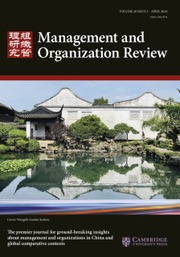No CrossRef data available.
Article contents
Viewing Organizational and Management Behavior through Different Lenses
Published online by Cambridge University Press: 10 April 2025
Extract
I am honored to be asked to write an essay on my involvement with Management and Organization Review (MOR) and the Chinese management research community. I was one of the founding senior editors of MOR at its inception in March 2005. I still have Volume 1, Issue 1 on my bookshelf in my office. From the start, it was a team effort with six senior editors, four consulting editors, a host of scholars on the editorial review board and the editorial advisory board, as well as ad hoc reviewers. The IACMR was an important partner and supporter of the journal. Anne Tsui was our editor-in-chief, but she knew how to involve the entire ‘village’ in the production of MOR, even those of us who were not bona fide Chinese management scholars but who would do everything they could to make the journal a success. We are indeed grateful to Anne, and everyone involved. It was an initiative at a grand scale.
- Type
- Editorial Essay
- Information
- Copyright
- Copyright © The Author(s), 2025. Published by Cambridge University Press on behalf of International Association for Chinese Management Research


